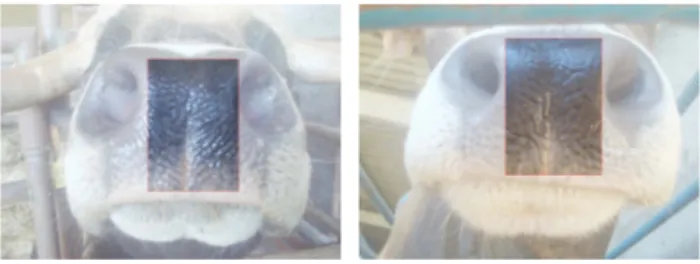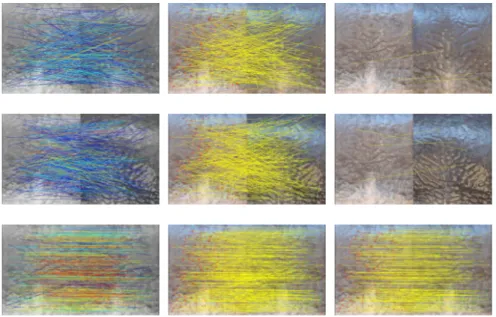International Conference
on Image Analysis and Recognition
ICIAR 2016
July 13-15, 2016 – Póvoa de Varzim, Portugal
FernandoC.Monteiro
PolytehniInstituteofBragança,Portugal.
Abstrat. Cattle muzzlelassiationanbeonsideredas a biomet-riidentierimportanttoanimaltraeability systemsto ensurethe in-tegrityofthefoodhain.Thispaperpresentsamuzzle-based lassia-tionsystemthatombinesloalinvariantfeatureswithgraphmathing. Theproposedapproahonsistsofthreephases;namelyfeature extra-tion,graphmathing,andmathingrenement.Theexperimentalresults showedthatourapproahissuperiorthanexistingworksasoursahieves anallorretidentiationforthetestedimages.Inaddition,theresults provedthatourproposedmethodahievedthishighaurayevenifthe testingimagesare rotatedinvariousangles.
1 Introdution
Cattleidentiationandtraeabilityplaysanimportantrolefordiseaseontrol, vainationmanagementand alsoformaintainingonsumerondene infarm produe. Today's animalidentiation is basedon ear nothing, branding and RFID tags.These markers,however,maybe lost and annot preventfraudin trade. The approah for beef attle identiation should be guaranteed to be permanent,diulttofaked,easytoaquire,inexpensive,aurateandhumane [4℄.Theuseofbiometriidentiationmethodsislesspronetoerrorsandfrauds andshould beexplored.
Themuzzle patterns ornose printof attlearethe uneven patterns onthe surfaeoftheskin ofthenose.Asngerprintsare uniquetohumanbeings,the ridgesandvalleysofeahow'smuzzleformapatternthatislikewiseuniqueto that animalasshownbyBaranovet al.intheirseminalpaper[3℄.
Theremainder of this paperis organizedas follows: Set. 2, desribes the usedmaterialsandtheproposedmethod. InSet.3,wepresenttheresultsand thedisussionofthendings.Finally,onlusionsaredrawninSet.4.
2 Materials and Methods
Thissetionexplainsaboutthedata,previousmethodsandtheproposedmethod forattleidentiationbasedondigitalmuzzle photodata.
2.1 Data aquisition
Severalauthorshaveusedmuzzlepatternthroughlifted inkprintsonapieeof paperfor theattleidentiation[4℄,[8℄. However,the dataapturing requires speial skills (e.g ontrolling the animal and gettingthe pattern on a paper), andthediultiesofthewetonditionoftheattlenoseandtheattlenervous feeling leading to smeared and motionblurred muzzle print [8℄. Using muzzle photos to reognize animalsby their muzzle pattern enablesthe identiation from adistantpointof view.Thus, theanimal will notbestressed oraeted in itsnaturalbehaviour.
Theimageshavebeenolletedfrom15animalswith5muzzleimageseah. InFig.1isshownasampleofmuzzleimagesapturedfromthreeanimals.Four of theolletedmuzzle photos ofeah individualare used asthe trainingdata andtherestisusedas thetestingdata.
Fig.1.Asampleofimagesolletedfromthreedierentanimals.
2.2 Previousmethods
Awadet al.[2℄ usedSIFT to detettheinterestingfeaturepointsforimage mathing.ThemuzzleimageorrespondingtotheSIFTfeaturevetorthathas theshortestEulideandistane totheinputfeature vetorisonsideredasthe most similar one. At the end of the mathing proess, the Random Sample Consensus (RANSAC) algorithm is used to remove the mismathed features, andensuretherobustnessofthesimilaritysore.
Tharwatetal.[9℄usedtheLoalBinaryPatterns(LBP)tehniquetoextrat loalfeatureswhihareinvarianttorotationandhangesintheimages(olour, texture, and pixel intensity). They also used Linear Disriminant Analysis to disriminatebetweendierentlasses.
Ahmed et al. [1℄ used the Speeded-Up Robust Features (SURF) feature point's information obtained from a set of referene images. In the training phase,the SURFfeatures arestored in matriesthat representthedesriptors ofeahimage.Afterthat,twodierentlassiersareused,namely,Support Ve-torMahinelassierandminimumEulideandistanetondimagemathing.
2.3 Loalinvariantfeature detetion
Inourmuzzlepatternreognitionapproah,bothatrainingandatestimageare representedasgraphsusingrepresentativefeatures,wheregraphmathingnds thepattern anditsorrespondingfeaturesbyminimizing thedistanebetween thetwographs.SinegraphmathingisaNPproblem,areduedsetofrelatively sparsesalientfeaturesanbeseletedandtheirproperrelationsanbeusedto buildtheassoiatedgraphdesriptor.
Inthe last years, SIFT features proved to perform well in fae reognition andobjetdetetion.Thesefeaturesarebasedontheappearaneoftheobjetat partiularinterestpointsandareinvarianttoimagesaleandrotation[7℄.They arealsorobusttohangesinilluminationandolusionwhihareveryimportant harateristisintheaseofimagesaquiredinanunontrolledenvironment.
2.4 Graph mathing
Wedeneanattributedgraphasagraph
G
= (
V, E, A
)
whereV
representsaset of nodes,E
, theedges betweennodes,andA
, attributes. Eahnodev
i
∈
V
or edgee
ij
∈
E
hasanassoiatedattributea
i
∈
A
ora
ij
∈
A
.Infeature orrespon-deneproblems,anodeattributea
i
usuallydesribesaloallyextratedfeaturei
inanimage,andanedgeattributea
ij
representstherelationshipbetweentwofeatures
i
andj
in theimage.Let
G
= (
V, E, A
)
andG
′
= (
V
′
, E
′
, A
′
)
betwoattributed graphs.The ob-jetiveofgraphmathingistodeterminetheorretorrespondenesbetween
V
andV
′
thatbestpreservestheattributesbetweenedges
e
ij
∈
E
ande
i
′
j
′
∈
E
′
. For eah pair of edges
e
ij
∈
E
ande
i
′
j
′
∈
E
′
there is an anity or similar-ity
w
ii
′
;jj
′
=
f
(
a
ij
, a
i
′
j
′
)
that measures the mutual onsisteny of attributes betweenthepairsofnodes.Forapairwiseedge similarity
w
ii
′
;jj
′
∈
R
+
0
betweentwomathes(
i, i
′
)
and
(
j, j
′
)
,weadoptthesymmetritransfererror(STE)used in [5℄.Given thetwo mathes,thetransfererrorof(
j, j
′
)
withrespetto
(
i, i
′
)
isomputedbasedon thehomographytransformation
T
ii
′
anddenoted byd
jj
′
|
ii
′
andformulatedasd
jj
′
|
ii
′
=
k
x
j
′
−
T
ii
′
(
x
j
)
k
.
(1)The lowerthe valueof the transfererror the better the homography transfers the feature points
v
j
to that of featurev
j
′
.d
jj
′
|
ii
′
+
d
j
′
j
|
i
′
i
2
representsthesymmetriversionof
(
i, i
′
)
.Thus, theSTE similaritymeasureisgivenby
w
ii
′
;jj
′
= max
0
, α
−
d
jj
′
|
ii
′
+
d
j
′
j
|
i
′
i
+
d
ii
′
|
jj
′
+
d
i
′
i
|
j
′
j
4
.
(2)Thismeasureisinvarianttosaleanddeformationhangesintheimages.As in [5℄weset
α
= 50
.A solution of graph mathing is dened as asubset of possible orrespon-denes representedwith anassignmentbinary matrix
X
∈ {
0
,
1
}
n
×
n
′
, where
n
denotesthenumberofnodesineahgraph,suhthatX
ii
′
= 1
impliesthatnodev
i
orrespondsto nodev
i
′
, e.g.featurei
in imageI
ismathed to featurei
′
in image
I
′
, and
X
ii
′
= 0
otherwise.The graphmathing problem anbe formu-lated asan integerquadrati program(IQP)[6℄, generallyexpressedasnding theindiatorvetorx
∗
thatmaximizesthequadratisorefuntion asfollows
x
∗
= arg max
x
T
Wx
s.t.
x
∈ {
0
,
1
}
n
×
n
′
,
X1
n
′
×
1
≤
1
n
×
1
,
X
T
1
n
×
1
≤
1
n
′
×
1
(3)
where the onstraints refer to the one-to-one mathing from
G
toG
′
.
1
n
×
1
denotesanall-onesvetor.
mathing onstraints and relaxing integer onstraintsfrom Eq. 3, the original IQPouldbeapproximatedtoaontinuousproblemas
e
x
∗
= arg max
x
e
T
W
e
x
,
s.t.
x
e
∈
[0
,
1]
nn
′
(4)whosesolutionisobtainedbytheeigenvetorassoiatedwiththelargest eigen-valueof
W
.Assumingthatthesolutionoftherelaxedproblemislosetothe op-timaldisretesolution,thenalsolutionisobtainedbyinorporatingthe math-ing onstraints. As the graph mathing module, we employed the reweighted random walkmathing (RRWM)algorithm proposedby Choand Lee[5℄.The Hungarianalgorithmisadoptedforthenaldisretization.2.5 Mathingrenement
Torrand Zisserman[10℄ proposed MLESAC(MaximumLikelihoodEstimation SAmple Consensus) whih is ageneralization of the RANSAC estimator. The mainideaistoevaluatethequalityoftheonsensussetalulatingitslikelihood rather than just the number of inliers. Instead of using heurist measures,the MLESAC evaluates the likelihood of the model hypothesis. It estimates the ratio of valid orrespondenes and is solved by an expetation maximization algorithm.
3 Experimental Results
Themuzzleimagesareapturedindierentillumination,rotation,qualitylevels and distane from the animal. Previous works standardized the set of muzzle images in orientationand sale [4℄. In ourwork theimages were used without anypreproessingoperation.Ineverymuzzleimage, aretangleregionentred ontheminimumlinebetweenthenostrilsistakenastheregionofinterest(ROI). TheillustrationoftheROIisshowninFig.2.
Fig.2.Highlightedretangle regionistheROIofthemuzzleimage.
3.1 Graph mathingresults
AnattributedgraphisonstrutedfromtheobtainedSIFTfeaturestoeahtest image.TheRRWMalgorithmisthenappliedtoobtainthemaximummathing sore aordingly to Eq. 3, normalized by the random walk step of RRWM. Figure 3shown the soreenoded in jet olour map with the minimumsore representedbyblueolourandthemaximumsorerepresentedbytheredolour.
Fig.3.Mathingsimilaritysoreenodedinthejet olourmap.
From Fig. 4 we an see that there are mislassied mathing features. To obtainanalmathingsorebetweentwoimageswerenedthegraphmathing result,usingtheMLESACalgorithm,in ordertodetettheinlierfeatures that followsthesameanegeometritransform,exludingthemismathedfeatures.
(a)Sore=1.0000 (b)Sore=0.4555
Fig.4.Mathing renement by deteting anetransformation. (a)Graphmathing detetedfeatures.(b)Renedmathingfeatureswiththesameanetransformation.
Our similarity sore was used to nd the training image with the highest sore and should not be mistakenly used asthe probability that an animal is identied.Ahighsoreisobtainedwhenthemajorityofthemathesfollowthe sameanetransformation,inreasingtheprobabilitythatitisthesameanimal.
3.2 Robustness to rotation
(a)Testimage (b)0.6878 ()0.3637 (d)0.4555
Fig.5. Samples of rotatedmuzzleimages indierent angles.(a) Testing image. (b) Another image of the same animal. () Image (b) rotated
20
0
left. (d) Image (b) rotated
20
0
right.Atthebottom,themathingsimilaritysorewiththetestingimage.
3.3 Identiation results
Aftertherenementgraphmathingproess,thetrainingimagewiththehighest soreisonsideredasthereognizedanimal. Someexamplesofgraphmathing renementareshowninFig.6.
Fig.6.Graphmathingfeatureorrespondenebetweenanimal9andanimals1,5and 9.Left:Featuremathingsimilarity.Centre:Mathingfeatures.Right:Renedresults.
Table 1.Mathingaveragedsoresobtainedbetweenveanimals.
Animal Cattle1 Cattle5 Cattle 9 Cattle 12 Cattle 15 Cattle1 0.5116 0.0376 0.0264 0.0220 0.0187 Cattle5 0.0227 0.2817 0.0143 0.0220 0.0194 Cattle9 0.0271 0.0190 0.7292 0.0197 0.0184 Cattle12 0.0487 0.0245 0.0325 0.4832 0.0256 Cattle15 0.0152 0.0127 0.0111 0.0101 0.5412
4 Conlusion
This paper proposed aattle identiation approah that uses muzzle images loal invariant features as input to graph mathing. The proposed method is robustfromthreeperspetives.First,itusestherobustnessoftheSIFTfeatures to imagesale, shift,and rotation.Seond,itusesagraphmathing tehnique thatpreservesthenodestrutureofthefeatures.Andthird,itusestheMLESAC algorithm asa robust outlier detetor for rening the graph mathing results andensuretherobustnessofthemathingproess.Theresultsprovedthatour method ahievedgoodresultseveniftheimagesarerotatedin severalangles.
Referenes
[1℄ S.Ahmed,T.Gaber, A.Tharwat,A.E.Hassanien,andV.Snael. Muzzle-based attleidentiationusing speedup robustfeature approah. InInt.Conferene onIntelligentNetworkingandCollaborativeSystems, pages99104,2015. [2℄ A.Awad,H.Zawbaa,H.Mahmoud,E.Nabi,R.Fayed,andA.Hassanien.Arobust
attleidentiationshemeusingmuzzleprint images. InFederated Conferene onComputerSieneandInformationSystems, pages529534,2013.
[3℄ A.S.Baranov,R.Graml,F.Pirhner,andD.O.Shmid. Breeddierenesand intra-breed geneti variability of dermatoglyphi pattern of attle. Journal of AnimalBreeding andGenetis,110(1-6):385392, 1993.
[4℄ B.Barry,U.Gonzales-Barron,K.MDonnell,F.Butler,andS.Ward.Using muz-zlepatternreognitionasabiometriapproahforattleidentiation. Transa-tionsoftheASABE,50(3):10731080, 2007.
[5℄ M.Cho,J.Lee,andK.M.Lee.Reweightedrandomwalksforgraphmathing.In EuropeanConfereneinComputerVision,pages492505.Springer,2010. [6℄ T.Cour,P.Srinivasan,andJ.Shi.Balanedgraphmathing.AdvanesinNeural
InformationProessingSystems, 19:313320,2007.
[7℄ D.G.Lowe. Distintiveimagefeatures fromsale-invariantkeypoints. Interna-tionaljournalofomputervision,60(2):91110,2004.
[8℄ A.Noviyantoand A.M. Arymurthy. Beef attleidentiationbasedonmuzzle patternusing amathingrenementtehniqueintheSIFTmethod. Computers andeletronisinagriulture,99:7784, 2013.
[9℄ A.Tharwat,T.Gaber,andA.E.Hassanien.Cattleidentiationbasedonmuzzle imagesusinggabor featuresand SVMlassier. InAdvaned MahineLearning Tehnologies andAppliations,pages236247.Springer,2014.




